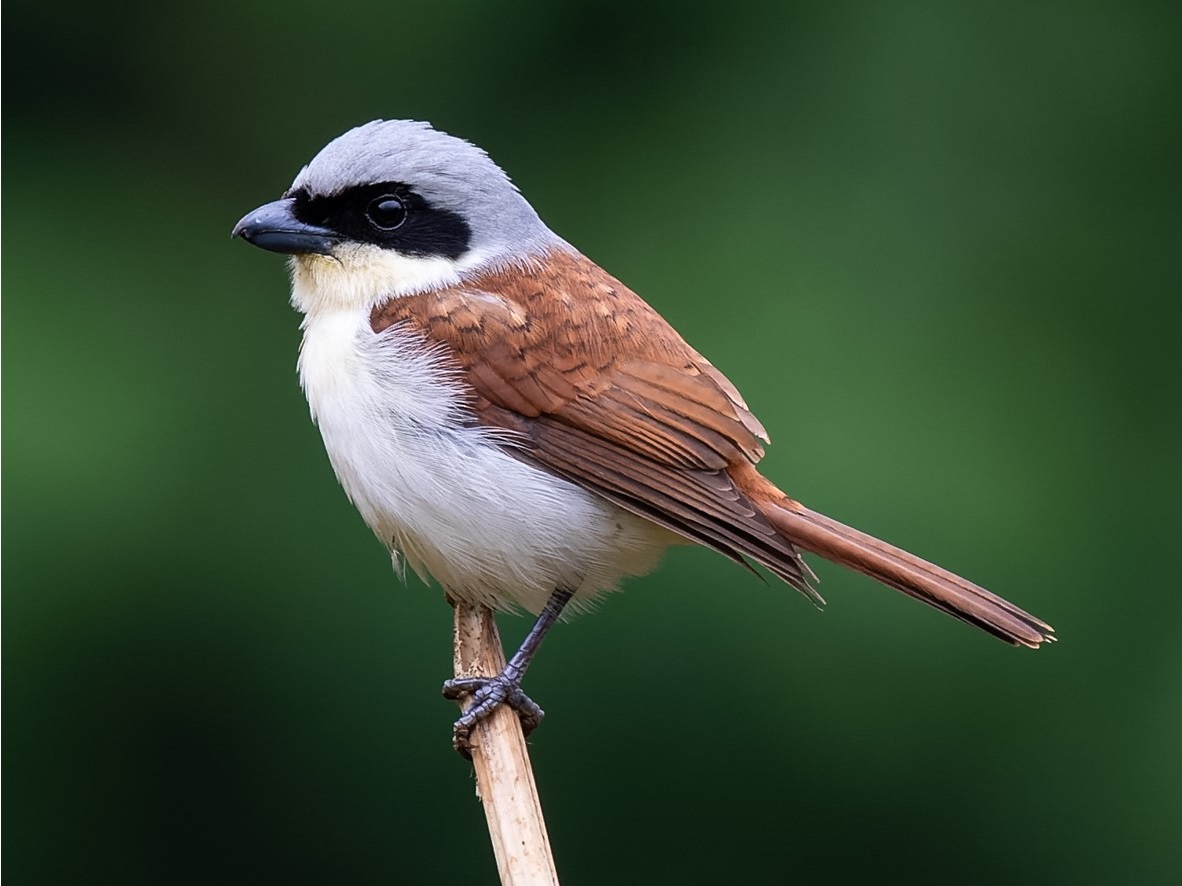Tiger Shrike 虎紋伯勞 Lanius tigrinus
Category I. Rare passage migrant to wooded areas in early autumn, with a single record in May.
IDENTIFICATION

Sep. 2019, Michelle and Peter Wong. First-year.
17-19 cm. A small shrike with large head, rather short tail and heavy bill with obvious hook. Barred upperparts and rufous wings and tail in all plumages (much brighter in adult). Lacks white patch on wing and white sides to tail.
Almost all birds seen in HK are first-year birds such as this, which are distinguished by pale lores, poorly-marked mask, large eye, largely pale bill, barred underparts and pale tips to tertials.

May 2019, Guizhou, China. James Kennerley. Adult male.
The male is brightly coloured with a contrasting grey head, black frontal band, lores and ear-coverts forming a facial mask and bars on the chestnut mantle. The female is duller with dark bars on flanks and belly.
VOCALISATIONS
A sharp slightly throaty ‘zwip’ or ‘zweet’ and a harsh rattle similar to other shrikes.
DISTRIBUTION & HABITAT PREFERENCE
Most records are from the edge of closed-canopy wooded habitats, reflecting the species’ habitat utilisation in its breeding and winter ranges. The lack of such cover on offshore islands is likely why there are few records even from the migrant trap of Po Toi. However, regular observations have revealed it is a regular visitor to urban park-like habitat at Ho Man Tin since 2016, with approximately one-third of records from this site.
OCCURRENCE
Tiger Shrike is a rare autumn passage migrant, occurring from the last week of August to the first week of October, peaking in the second week of September (Figure 1). Extreme dates are 24 August 2018 and 14 October 2017. The single spring record on 23 May 2017 at Ho Man Tin is also the only record of an adult male. All other records are of first-years.
There were only 14 records between 1979 and 2015, but an increase in observer coverage means it has been recorded annually since 2016. Usually no more than four birds per annum are recorded except for an unprecedented eight in 2017.
The first substantiated record of Tiger Shrike in HK referred to a bird seen on Cheung Chau on 5 September 1979 (Cooper 1981).
BEHAVIOUR, FORAGING & DIET
Perches at the top of bushes or in the lower branches of forest edge trees as it scans the ground for invertebrates; however, no data on prey consumed.
RANGE & SYSTEMATICS
Monotypic. Breeds in extreme southeast Russia (Ussuriland), northeast and east China (east from Shaanxi, Sichuan and Guizhou), the Korean peninsula and in Japan; in the non-breeding season occurs from east Myanmar to Peninsular Malaysia, Singapore, north Laos, central Vietnam and the Greater Sundas (Yosef et al. 2020). Although the latter work indicates the non-breeding range includes south China, the pattern of records in HK suggests that this must be exceptional.
CONSERVATION STATUS
IUCN: Least Concern. Population trend decreasing.
Figure 1.

Chalmers, M. L. (1986). Annotated Checklist of the Birds of Hong Kong. Hong Kong Bird Watching Society, Hong Kong.
Cooper, G. C. H. (1981). Systematic List for 1979. Hong Kong Bird Report 1979: 8-43.
Liu, Y. and Y. H. Chen (eds) (2020). The CNG Field Guide to the Birds of China (in Chinese). Hunan Science and Technology Publication House, Changsha.
Vaughan, R. E. and K. H. Jones (1913). The birds of Hong Kong, Macao and the West River or Si Kiang in South-East China, with special reference to their nidification and seasonal movements. Ibis 1913: 17-76, 163-201, 351-384.
Yosef, R., ISWG International Shrike Working Group, and E. de Juana (2020). Tiger Shrike (Lanius tigrinus), version 1.0. In Birds of the World (J. del Hoyo, A. Elliott, J. Sargatal, D. A. Christie, and E. de Juana, Editors). Cornell Lab of Ornithology, Ithaca, NY, USA. https://doi.org/10.2173/bow.tigshr1.01

